Posture and Rowing
August 25, 2011
By Bob Kaehler MSPT,CSCS
Posture is a culmination of life’s activities and tendencies. At the same time, our posture inevitably reflects our effort and commitment to improving it, or in some cases not. While ideal posture is different for each person, there are some key body alignment areas that are certain positions. For example when your back is against a wall your ears should be directly over the shoulder joint and your head should be touching the wall with your chin parallel to the ground. Infants and toddlers start out with a clean slate, and have an ideal body alignment from the get-go. They are flexible and strong at the same time. Like a world-class Olympic lifter, they can easily get into positions that many would cringe at. Barring any genetic or birth defect, the fact is that most of us could still easily get into these ideal positions if we had perfect posture. So what happened? Life, gravity, and normal daily activities. They slowly undermine our clean-slate posture. Fortunately, one thing I have learned through my years of practice is that we are capable of restoring much of the flexibility and strength we once had through hard, consistent work and a solid well-balanced plan.
Gravity creates a constant pull on the body when we are standing, sitting, or rowing in a boat. Years of postural neglect lead to the development of poor postural habits, and the inability to maintain good posture for more than a few moments. Poor standing posture only gets worse when you get in a boat. When we stand, our hips are free to move forward and back as we do in daily activities. However, in a boat, we lose this ability and the hips shift the force to other areas of the body, namely the trunk and lower extremities. Keeping the spine in a good upright position then becomes difficult and tiring, especially when you have flexibility and strength limitations. A common rowing posture is what I call the “turtle shell”, or “rounded” position, where the spine (low and mid-back) are flexed or rounded. This spine position places increased stress on the passive tissues of the spine and ribs (discs, ligament, and bone). While the spine is amazingly resilient, prolonged periods of rowing at high intensity and volumes ultimately lead to back and rib injuries.
To improve posture, flexibility is always the priority and must be addressed first. I like to say “if you can’t get there, you can’t strengthen it”. Having excellent range of motion helps athletes get into ideal sporting positions. In rowing, two critical areas for flexibility are in the hamstrings and the latissimus muscles. Tightness in either area or both leads to the likelihood of rowing in the rounded back position. The drive of the rowing stroke is essentially a horizontal Olympic power clean. I use this movement as my model for flexibility, strength, and spine position, to help rowers develop maximum power with least chance for injury. The only difference between the rowing stroke and Olympic power clean (aside from horizontal vs. vertical) is that in rowing our hips are not free to move (seat). This fact alone (hips fixed by the seat) leads to a greater need of flexibility, and is also the reason why we can’t get the spine into a fully extended (curved or lordotic) position during a rowing stroke.
Strength is also an important consideration for maintaining better rowing posture. Without a conscious effort to maintain good posture in the boat, most rowers slump down into the rounded position. This position is easiest to maintain because it requires little to no energy to maintain it. As flexibility improves, it becomes easier to strengthen the spine into an extended position. Strengthening the spine against gravity (in standing) is an excellent way to help promote a more extended or straight position of the trunk/spine in the boat.
Making the shift to better posture requires considerable work and effort, but becomes habit over time. Sitting upright then becomes second-nature. There are two very effective exercises that can be used for both improving flexibility and strength, and target the hamstrings, lats and spine. The first is the straight leg dead lift which targets the hamstrings, glutes and back extensor muscles. This exercise can be used to stretch the hamstrings using a dowel or stick, or as an exercise to improve strength in the hamstrings, glutes and back extensor muscles by using a barbell or dumbbells. The other exercise is the overhead squat which is a great way to stretch out the lats. If weight is added (barbell), this exercise increases strength in the low back, quads, glutes, hamstrings, trunk and other muscles. Proper coaching instruction will help maximize the results from these two lifting techniques. Both exercises can be used as either a stretching or strengthening exercise to improve your posture both on land and in the boat.
Ideal posture will not only translate into more effective, efficient and powerful rowing, but will also extend into all your day-to-day activities of our lives outside the boat. So sit-up, stand-tall, and make a conscious and balanced effort to improving your posture.
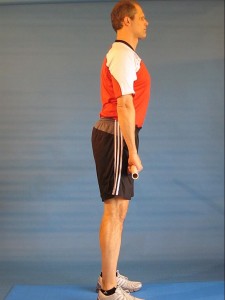
Straight Leg Dead Lift - Start Position
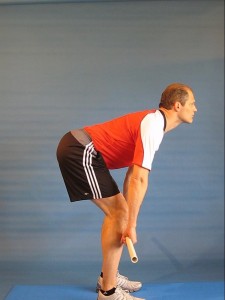
Straight Leg Dead Lift - Finish Position
Getting Back in Rowing Shape! – Warner Bonner Henley 2011
August 21, 2011
I guess this is more of a thank you letter to Bob and head’s up to all you Master’s rowers out there. So, first and foremost… a sincere “THANK YOU” to you Bob! Your body-balance training program and calculated approach to ramping up my complete core fitness was without a doubt, incredible.
To the master’s rowers… I am nothing special as far as a rower goes, not an Olympian or anything of the sort, but Bob took my 6’05” 243 lb. frame in 3 months to 220lbs and helped me drop a sad 6:28 2k erg down to solid master’s score in the low 6 minute range at 38 years old.
By the fourth month, he had me racing for Penn AC Masters in the Ladies Plate Challenge at the famed Henley Royal Regatta in England. I was racing with some the best US master’s rowers out there (Grant Nichols, Garrett Klugh, Ivan Smilijac, Jack Nunn and Sebastian Bea). We traded blows with the 2010 defending Henley Champions and 2011 IRA silver medalist, Harvard’s Varsity Heavy 8 who took us in the quarterfinal by just 6 seats, not bad for bunch of old guys with only three (3) full practices together.
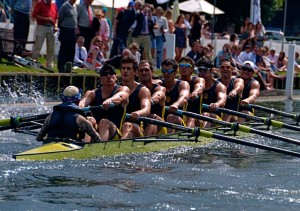
Penn AC Ladies Plate Henley 2011
As a bit of background and to really appreciate what Bob did for me in a short 4-month program, you sort of need to look at where I was physically when I started training with Coach Kaehler. I had not truly trained for a rowing race in more than15 years when I prematurely ended my rowing career in pursuit of another athletic goal, sprint kayaking.
In 1997 I switched sports to train with Bob’s former Olympic teammate, Chris Swan on the US Sprint Kayak team for the 2000 Games. During this time I completely changed my ‘rowing body’ into and competitive sprint kayaker’s body. I lost the power in my legs and gained a much larger upper physique. After 2000, I started rowing a bit again, went to the US Trials in 2001 with Brian Klepacki but really was never too competitive again.
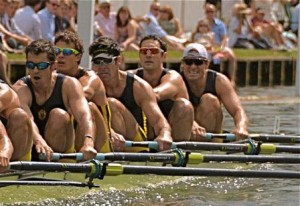
Ladies Plate 2011
Between 2001 and 2010 I did the random master races every year but never really took them too serious. I fell into doing long distance triathlons (half Ironmans and full Ironmans) and REALLY started to loose muscle mass. In 2010, I looked like a rower due to my height but the raw rowing power simply was not in me. Due to all this alternative training, Bob felt it was critically important to get my body “balanced” right away.
In the fall of 2010 my former teammate from the 1995 USA Pre-Elite and Olympic Fest Team, Curt Browder, asked my bud, Sebastian Bea (2000 2- USA Olympic Silver Medalist) and I to row in the Penn AC Men’s Master 8 at the Charles. The last time I trained out Penn AC was in 1995. During that fall race, I sort of fell back in love with the sport, in a major way. Sort of a nostalgic mid life crisis thing that I bet many a Master Rower goes through at some point.
After a solid performance in a few fall races, we started chatting about the idea of Henley after seeing rowing legends Porter Collins, Ben Holbrook and Jamie Koven threw down some solid performances in their Brown Alum line-ups. When I learned of the Brown Alum’s using Bob’s program, I quickly gave him a call and got on board.
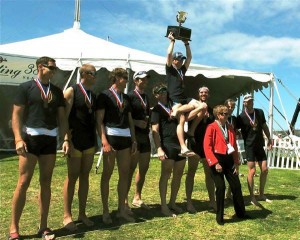
San Diego Crew Classic 2011
I have done all kinds of training; from Crossfit to personal trainers but what was magic about Bob’s program was it was designed for me, on a daily basis and did not take up too much time. From the detailed erg workouts that built up my base to the lactic work, it was the most efficient program I have ever come across. The first thing I noticed was my strength and after a short month of training we took gold in the Master’s event as Penn AC at the San Diego Crew Classic, I
was really starting to feel much more strong, as if the “hands of father time” were starting to turn back.
After the Crew Classic, we started to get serious, as I was only a few months out from Henley. As the intensity of Bob’s workouts increased, the single most important thing for me, from a motivational perspective, was that I knew who Bob is. I was well aware of what a stud he was in sport of rowing. Knowing how long Bob rowed at an international elite level, well into his thirties… motivated me as to what was physically possible at nearly a Master’s C level of 40 years old.
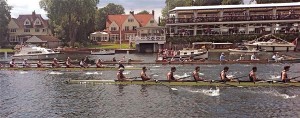
Ladies Plate - Finish Against Harvard 1V
Coming into the final few weeks, I ventured up to Penn AC for a few weeks to train with their Elites. This was a major wake-up call for me as my first day on the water consisted of us doing race pieces. While it took some time for me to get my timing and technique down… my engine was there. My fitness was never an issue and by the end of my time in Philly, we were trading pieces with Penn AC’s top boats.
The Henley was truly an incredible experience and I recommend it to any Master out there. The Ladies Plate event is very competitive with the likes of Leander, Germany, Ireland, Russia and Imperial in the event.
We posted a time that would have won our event 9 times in the last 20 years. So… once again, THANK YOU BOB! My Henley experience would not have happened without you!
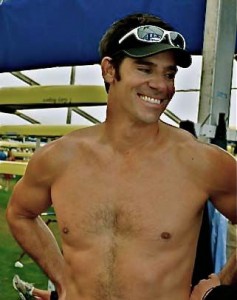
Warner Bonner - Henley 2011
Wrightstown, PA
August 14, 2011
From Back Pain to Back on the Erg
August 3, 2011
High School Athlete PR’s using Coach Kaehler’s Body Balance Program
By Yasemin Watkins
The following is a testimonial from a parent, Mike, and his daughter, Megan, who wanted to share their Body Balance experience with other athletes looking for effective solutions to sports-related injuries. At this time, they wish to keep the personal details (names, etc.) confidential between them and Coach Kaehler.
In rowing terms, Megan’s story is a familiar one. Megan is a varsity rower on a nationally top-five ranked high school team based in Pennsylvania. Megan suffered from severe back pains that greatly limited her ability to participate in key components of her team’s winter training program. Confused yet determined to help his daughter, Megan’s father, Mike, consulted several medical specialists including a pediatric sports doctor and an orthopedic surgeon. Unfortunately, both doctors were unable to relieve Megan’s back pain.
Frustrated, Mike took Megan to one last orthopedic surgeon who then referred them to Coach Kaehler.
“Bob’s reference from an orthopedic surgeon carried a lot of weight,” said Mike. “As a parent, I just wanted to see my daughter be able to continue and progress in a sport she loves.
During our first conversation with Bob, he said that he would need one assessment, and that he was convinced that she would be able to return to rowing in a certain period of time. I was so impressed: he delivered on all his promises.
He did identify the problem; he did it in one meeting; and she did recover in 6 weeks. Best of all, (shortly after) Megan PR’d when she took her 2K erg test.
I felt like he was really looking out for my daughter.”
Regarding the evaluation, Mike commented,
“As Bob walked us through the assessment, he explained the dynamics of the muscles used in rowing and erging – everything made sense.”
Of their overall experience working with Coach Kaehler, Mike had this to say:
“Bob’s own track record, both as a medical professional and as a world-caliber athlete, made him more credible. Bob instilled in Megan a level of confidence to carry out the exercises and return to competitive rowing.
Bottom line: as a parent, I’m tremendously relieved that my daughter can now return to rowing – both competitive and as an activity that she can enjoy for the rest of her life. Without hesitation, I would highly recommend Coach Kaehler to any rower having (training-related) issues.”
**Coach Kaehler’s Body Balance Process is not medical treatment, and he does not treat pain. Body Balance issues are identified and corrected to allow restoration of powerful and pain-free training. All of his client’s have gone through traditional medicine channels first and have been screened by a medial physician (M.D. or D.O.).
Training Hard? Breathe Easy.
August 1, 2011
Yoga-based techniques to help improve your athletic performance
By Yasemin Watkins for Coach Kaehler
What’s one way you can improve your athletic performance using Pranayama –yoga-based breathing techniques?
According to Ed Harold, co-owner of Comfort Zone Yoga Center for Whole Self Healing, focus on your diaphragm – the dome-like muscle which separates your thoracic cavity from your abdomen and assists in your breathing.
“Learn to ‘thicken’ your diaphragm muscle,” says Harold. “The stronger the muscle, the greater your ability to lift and expand your chest cage.”
Harold, otherwise known as the “athletic yogi,” has been a lifetime competitor in everything from football to water sports, but confesses that his “greatest love of all is rowing.”
After sustaining a series of low-back and knee-related injuries, Harold turned to yoga for relief, recovery and eventually an entirely new approach to athletic training.
Through his studies to become a certified yoga instructor, Harold learned various yoga-based breathing techniques, Pranayama, and started integrating them into his athletic programs.
Here are some of Harold’s suggestions for integrating yogic-based breathing techniques into your own training programs:
Breathe through your nose at least 50% of your workout
Nasal breathing supports good posture in low back.
“Warming up using nasal breathing also activates the parasympathetic branch of the autonomic nervous system which sets your body into a fat burning zone rather using vital sugar reserves,” says Harold.
Mouth breathing, on the other hand, “doesn’t move the diaphragm as well and only activates the sympathetic branch hormones which athletes should reserve for racing and intense pieces.”
Harold recommends breathing through your nose, moving your diaphragm up and down at least 50% of your workout.
“Your first awareness of breathing using this approach is an ‘ocean’ sound in
your trachea, not your nasal channels,” offers Harold. “To do this, slightly constrict the upper trachea (epiglottis muscles in your throat). This will help control the length, depth, pace of inspiration and expiration.”
Use a ‘four-part breath’
Working with a four part breath: inhale, hold breath in, exhale, and hold your breath out.
“This technique warms-up your body quickly without wearing out joint tissues and destroying muscle mass,” says Harold. “Use mental or stroke counting to hold the left cortex present and in moment. Hold your breath in to increase the energizing effects of oxygen deeper into the nervous system. Then hold your breath out to remove stale air out of alveoli sac’s in your lungs.”
Observe the length of your inhales and exhales
Learn to manage your heart rates by noticing the length of your exhales and inhales.
“When your exhale shortens to less than your inhale, you are stressing your body and beginning to leave your ‘comfort zone,” says Harold.
Relax facial muscles
Relax low jaw, cheek bones, relax muscles around the eyes and don’t move
crown of head
For more information on these and other yogic-based techniques and programs Harold teaches, visit www.comfortzoneyoga.com.
(We don’t believe that there is any one magic bullet to success – and that hard work, excellent training plans and great coaching lead to success and we try and add value and serving you in your quest for success. Our programs are intended to help you get to the next level and the information above can help you better understand the many facets that should be addressed. As stipulated by law, we cannot and do not make any guarantees about your ability to get results using our ideas, information, tools or strategies , or from third-party information we share with you. We don’t know you and, besides, your results in life are up to you. Agreed? We just want to help by giving great content, direction and strategies that move you forward, faster. Nothing on this page or any of our websites is a promise or guarantee of future training success. “These above techniques / approaches may not necessarily reflect the opinion of Coach Kaehler.” )
